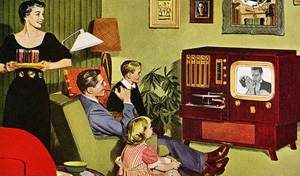1950s Ladies high heels
Stiletto Heeled Opera, court and pump shoes were all the rage in the early 1950s. At an extreme, they were very tall with 4-inch spiked ultra thin heels. Early on, the heels ended in a small metal cap that left dents in softwood floors, requiring some museum and courthouses to forbid stiletto shoes. The stiletto featured tall arches with a V-shaped cut away from the shoe sides. Red was the boldest and most in-demand color for formal wear. They were impractical and mostly only worn for very special occasions, short durations, and by fashion models.
The Winklepicker was an extreme version of the already extreme opera pump. With its sharp pointy toe and high thin heel, it was trendy in the late 1950s for formal and even semi-formal at home wear.
Thicker but still shapely tall heels continued to be worn with fancy dresses. Some heels had pretty all over designs carved, painted or printed onto them, while others had decorations around the edges.
Strappy tall heel shoes were another ideal shoe for evening wear. Ultra-thin T-straps, slingbacks and ankle straps all provided just enough coverage to keep the shoe on but ultimately made the foot look bare. Especially in nude colors and sometimes clear plastics, they complimented dreamy party dresses elegantly.
Kitten Heel Shoe After trying to balance on tall heels, most 1950s women regained their senses and accepted low but still thin kitten heel shoes. These classic dress shoes were safer to walk in yet still remained elegant and classy. Shoes were made of a soft leather or reptile skin. Suede and some fabric materials, like velvet or mesh, were used as well. Toes were very pointed in the early years and more rounded in the later years. For evening wear, jewel tone colors, especially glittery gold and dark silver, were fashionable.
Baby Dolls. They featured very round toes that resembled a doll’s shoes. They came in many fun colors during the spring and summer, with cute accent decorations on the trim or an ornament on the vamp.









































